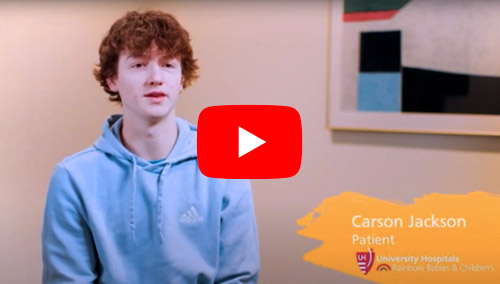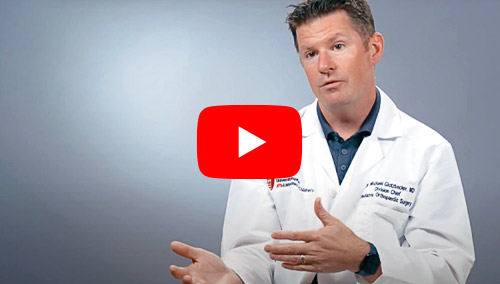Treatment for Kyphosis, Severe Scoliosis and Other Spinal Deformities
The Spinal Deformity & Scoliosis Center offers experienced and internationally recognized physicians to help children with scoliosis and other congenital spinal deformities.
Your child’s health is important. Don’t delay care.
Offering in-person, video and telephone visits. Call today to see which option is right for you. 216-844-7200
Schedule OnlineThe Spinal Deformity & Scoliosis Center offers many unique features which set it apart from other programs, including an expert staff who can diagnose and treat a wide range of pediatric spine conditions, including:
- Scoliosis (idiopathic, congenital, neuromuscular and early onset scoliosis)
- Spondylolysis and spondylolisthesis
- Kyphosis
- Back pain
- Spinal injuries
- Spinal tumors
Frequently Asked Questions
Treating Severe Pediatric Spinal Deformities with Traditional and New Approaches
Traditional surgical techniques for pediatric patients with severe spinal deformities can be used in older children and adolescents with great success. However, very young children are different because they are still growing and complete fusion surgery can limit development. Our pediatric orthopaedic surgeons have helped develop surgical and non-surgical techniques that allow for the continued growth of children with spinal deformities.
Using Advanced Techniques
To reduce pain and potential complications, orthopedic surgeons at University Hospitals Rainbow Babies & Children’s Hospital employ advanced surgical techniques that include:
- Medicines that reduce blood loss during spine surgery
- Spinal anesthesia
- Robot-assisted spinal fusion and navigational platforms to make surgery safer, faster and smarter
- ApiFix, a less-invasive alternative to spinal fusion
- Growing rod technology – including the Shilla™ and MAGEC™ growing rod systems
- Tether™ Vertebral Body Tethering System in younger patients with idiopathic scoliosis
- Firefly® Technology
- Vertical expandable prosthetic titanium rib (VEPTR)
- Pulse surgery platform
- Neuromuscular monitoring
- Posterior-only spinal fusion with spinal osteotomy to hasten healing
- Risser casting and thoracolumbar (trunk) bracing
Another advanced tool we utilize is EOS imaging, which is a low-radiation X-ray technology that provides information-rich, weight-bearing images by scanning a patient in either a standing or sitting position using a low dose of radiation. EOS Imaging can simultaneously take full-body, frontal and lateral images of the musculoskeletal skeletal system, making it useful in the diagnosis and treatment of kyphosis, severe scoliosis and other spinal deformities.
Offering Spinal Surgery Options Tailored to Patients’ Unique Needs

Dr. Glotzbecker discusses the full range of surgical options to treat common to complex spinal conditions.
Watch NowMaking Spine Surgery Safer for Kids

Watch Dr. Glotzbecker explain the benefits of navigational platforms like Pulse and how they are the future of surgery for children with scoliosis and complicated spine conditions.
Watch NowPatient Stories
Read how the latest advancement in scoliosis surgery and techniques help treat patients with spinal deformities & scoliosis.
Find Scoliosis Doctors Near You
Learn more about the pediatric orthopedic surgeons at UH Rainbow and schedule an appointment today.
Why Choose UH Rainbow for Pediatric Spine Care?
UH Rainbow is a global leader in the management of pediatric spinal deformities. Some of the features that set our program apart include:
- World-renowned pediatric orthopedic physicians who are board-certified experts with specialty training to provide complete and individualized spine care for your child. Our orthopedic surgeons have helped develop surgical and nonsurgical techniques that allow for the continued growth and successful care of children with spinal deformities.
- Recognized as a Best Children’s Hospital in Orthopedics by U.S. News & World Report.
- Access to Pulse, an advanced technology designed to increase safety, efficiency and procedural reproducibility of surgical outcomes in pediatric spine surgery. In a single platform, Pulse integrates radiation reduction, imaging enhancement, rod bending, navigation, intraoperative neuromonitoring, and spinal alignment tools.
- A team of pediatric spine surgeons, advanced practice/specialty nurses, anesthesiologists, child life specialists and physical therapists who diagnose, treat and manage a full range of spine-related deformities and conditions.
- UH Rainbow Babies & Children’s Hospital developed spinal cord monitoring, a system used worldwide to help make spinal surgery safer for both children and adults.
- The most experienced in the region for treating difficult early-onset scoliosis, including non-operative and new surgical options that can help decrease the need for repeat surgeries among still-growing children.
- A continuum of care within the University Hospitals system that enables us to transition teenage patients seamlessly to adult orthopedic care.


